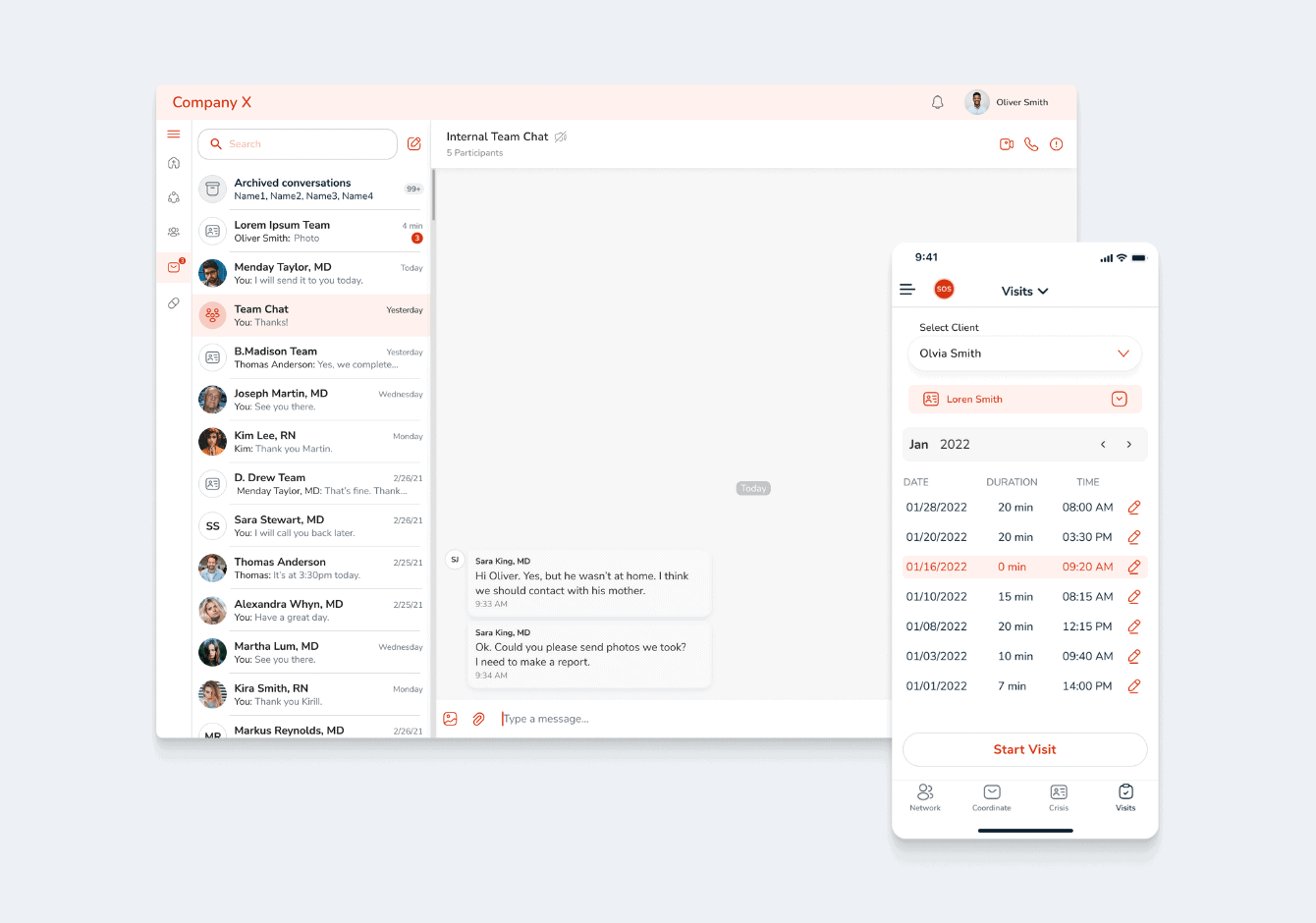Digital health has become a cornerstone of healthcare services in developed countries worldwide. Fortune Business Insights estimates that the telemedicine market will reach $286.22 billion by 2030, up from $94.44 billion in 2023, which equals a 17.2% compound annual growth rate.
With the growing volume of telehealth solutions, systems’ versatility also increases. Providers can choose between solutions for synchronous or asynchronous care, apps tailored for web or mobile devices, and telehealth systems for various modalities, be it mental health, pediatrics, or nursing.
Such a rich choice complicates the selection of the most suitable option for healthcare practices. Each system type offers specific benefits, has limitations, and is most effective in different scenarios. So, how do you decide which one is for you?
This blog post will explore the diverse types of telehealth systems and their unique features, examples, and uses to simplify the choice.
What Is a Telehealth System?
Telehealth is the provision of healthcare services remotely through the use of technology. These systems leverage telecommunications technology to provide medical care, patient monitoring, consultation, and education over a distance. Telehealth services can be delivered through various formats, such as video conferencing platforms, mobile applications, and phone calls.
Telehealth Types by Functionality
Telehealth encompasses a broad range of services and technologies, and its classifications vary based on different criteria. Here, we focus on categorizing telehealth systems by their functionality and core characteristics. The functionality determines the mode of communication, privacy issues, convenience, and many other aspects you must consider while choosing a telehealth system.
Let’s explore telemedicine types based on their specific functions and how each type contributes to healthcare delivery.
Traditional Telehealth
Traditional telehealth involves real-time, interactive services provided through video conferencing or telephone calls between healthcare providers and patients. It also supports asynchronous care through secure messaging platforms. This modality enables direct communication and consultation, allowing healthcare professionals to assess, diagnose, and treat patients remotely.
| Primary usage | Chronic disease management, post-operative follow-ups, and prescription refills |
| Telehealth examples | Teladoc, Amwell, and Doctor on Demand |
eVisits
eVisits, or virtual video visits, involve real-time (synchronous) clinician and patient interactions using audio and video technology or live chats. eVisit software is the most common choice for urgent care and outpatient rehabilitation clinics. It’s also a convenient way to ask for a second opinion from another doctor.
| Primary usage | Urgent care, outpatient rehabilitation clinics, minor health issues |
| Telehealth examples | Zoom, VSEE, Doxy.me |
Remote Patient Monitoring
Remote Patient Monitoring (RPM) involves the use of connected devices to collect and transmit health data from patients to healthcare providers. Such continuous monitoring software helps manage chronic conditions by providing real-time data.
| Primary usage | Chronic diseases like diabetes, hypertension, and heart disease that require ongoing monitoring and data collection, postoperative care, and elderly care |
| Telehealth examples | Philips Remote Patient, Monitoring, Health Recovery Solutions (HRS), and Medtronic Care Management Services |
Mobile Health
Mobile Health (mHealth) delivers health services through smartphones and tablets. mHealth solutions include health apps, wearable devices, and mobile health interventions designed to promote health and manage diseases. These applications can track fitness levels, monitor vital signs, manage chronic conditions, remind patients to take medications, and provide real-time health information and advice.
| Primary usage | Fitness tracking, medication adherence, and preventive health measures where mobile accessibility and convenience are key |
| Telehealth examples | Fitbit, Apple Health, and MySugr diabetes management app |
Selecting the appropriate type of telehealth service depends on the specific needs of the patient and the nature of the healthcare issue. Traditional telehealth is ideal for regular virtual consultations, ongoing care, rural telerehabilitation, and chronic disease management. eVisits are best suited for outpatient rehabilitation clinics where synchronous interactions between clinicians and patients are effective, such as in remote consultations and follow-up appointments. Remote patient monitoring is beneficial for managing chronic conditions that need continuous data tracking and for postoperative and elderly care. Mobile health is perfect for health tracking, medication adherence, and preventive health measures, as it provides the convenience of mobile accessibility and real-time insights.
| Telehealth by functionality | Special Features | Modes of communication | Limitations | Uses |
|---|---|---|---|---|
| Traditional telehealth | Ongoing care management, medical history | Video calls, live chats, phone calls, messaging | Delayed response time | Virtual consultations, prescription refills, rural telerehabilitation |
| eVisits | Real-time (synchronous) interactions | Audio and video | Dependency on simultaneous availability of the patient and doctor, language barriers | Urgent care, outpatient rehabilitation clinics |
| Remote patient monitoring | Integration with wearable devices, real-time data tracking | Automated alerts, messaging | Reliance on patient compliance, data privacy concerns | Chronic disease management, post-operative monitoring |
| Mobile health | Integration with smartphone sensors, personalized health insights | Push notifications, in-app messaging | Compatibility issues across devices, data security risks | Health tracking, medication reminders |
Types of Telehealth Systems by Care Modality
With telehealth advancements, specialized systems tailored to specific types of telemedicine services have emerged. Today, they are becoming increasingly specialized and adapted to particular care and healthcare needs. For instance, there are telehealth platforms specifically designed for mental health therapy, chronic disease management, pediatric care, and even dental consultations. These specialized systems often include unique features that cater to the particular requirements of the niche they serve, such as secure video conferencing for psychiatric evaluations, continuous glucose monitoring for diabetes management, or interactive educational tools for pediatric patients. Therefore, if you are working in a particular niche, consider developing or integrating a telehealth system specifically designed for it.
Let’s delve into the different types of telemedicine categorized by the type of care and their uses for different healthcare services.
Telehealth Software for Therapists
Telehealth software for therapists provides a platform for licensed mental health professionals to conduct therapy sessions with clients via video calls, secure messaging, and sometimes phone calls. Teletherapy platforms are designed to ensure client confidentiality and comply with health privacy laws like HIPAA.
| Primary usage | Individual and group therapy sessions, psychological assessments, and ongoing mental health support |
| Telehealth examples | BetterHelp, SimplePractice, and TheraNest |
Telemedicine Systems for Pediatricians
Telemedicine systems for pediatricians are tailored to the specific needs of children’s healthcare. These platforms facilitate virtual consultations for diagnosing and treating pediatric illnesses, offering parental guidance, and monitoring developmental milestones.
| Primary usage | Remote consultations for common pediatric conditions, monitoring chronic conditions like asthma or diabetes in children, and providing parental education on child health and development |
| Telehealth examples | Anytime Pediatrics, Pediatric Telehealth by American Well, and BlueJeans Telehealth |
Telehealth Systems for Nurses
Telehealth systems for nurses enable nursing professionals to provide patient care remotely, including conducting health assessments, managing chronic diseases, and delivering follow-up care. These systems often include tools for remote patient monitoring and health education.
| Primary usage | Chronic disease management, post-operative care, patient education, and health monitoring for patients requiring regular check-ins |
| Telehealth examples | CareSimple, VSee, and Vivify Health |
Telemedicine Systems for Dermatology
Telemedicine systems for dermatology allow dermatologists to evaluate skin conditions through high-resolution images and video consultations. Patients can submit photos of their skin issues, which dermatologists review to provide diagnoses and treatment plans.
| Primary usage | Diagnosing and managing skin conditions such as acne, eczema, psoriasis, and suspicious moles |
| Telehealth examples | DermTech, DermatologistOnCall, and SkinVision |
Telerehabilitation
Telerehabilitation involves the delivery of rehabilitation services through telecommunication technologies. It includes physical therapy, occupational therapy, and other rehabilitative services provided via video conferencing and remote monitoring tools.
| Primary usage | Post-surgical rehabilitation, chronic pain management, stroke recovery, and ongoing physical therapy exercises that can be supervised remotely |
| Telehealth examples | Physitrack, Hinge Health, and RehabPath |
Telehealth Platforms for Mental Health
These platforms offer comprehensive mental health services, including therapy, psychiatric consultations, and medication management. Additionally, they often provide self-help tools that enable users to engage in activities such as meditation, breathing exercises, and sleep improvement techniques.
| Primary usage | Mental health consultations, therapy sessions, and self-help activities improving mental well-being |
| Telehealth examples | Talkspace, Brightside, Calm, and MDLive |
Each type of telehealth system enhances the efficiency and accessibility of care. However, this list is not exhaustive. Telehealth systems can be developed or adapted to fit any specific use case. Our expertise lies in helping you design and implement a telehealth system that perfectly aligns with the particular needs of your practice.
| Telehealth by care | Special Features | Modes of communication | Limitations | Uses |
|---|---|---|---|---|
| Therapeutics | Secure video conferencing, EHR integration, appointment scheduling | Video calls, messaging, virtual visits | Data privacy concerns | Individual therapy sessions, group therapy, counseling |
| Pediatrics | Interactive tools for children, growth chart integration | Video calls, messaging, virtual visits | Dependence on caregiver presence, challenges in keeping children’s attention during virtual visits | Child visits, developmental assessments, pediatric consultations. |
| Nursing | Remote monitoring devices integration, care coordination platforms, patient education resources | Video calls, messaging, phone calls, remote data tracking | Technical challenges for older patients | Patient education, medication management, post-discharge follow-ups |
| Dermatology | High-resolution image capture, dermatoscope integration, automated appointment reminders | Video calls, secure image transfer, messaging | Reliance on visual assessment, potential for misinterpretation of images | Diagnosis of skin conditions, follow-up consultations, treatment planning |
| Rehabilitation | Virtual exercise programs, remote monitoring of progress, interactive rehabilitation games | Video calls, messaging, remote monitoring devices | Challenges in adjusting exercise intensity remotely, reliance on patient compliance | Physical therapy sessions, exercise prescription, post-surgery rehabilitation. |
| Mental health | Virtual waiting rooms, self-help tools (e.g., meditation, breathing exercises, sleep improvement), patient scheduling, digital record-keeping | Video calls, chat, phone calls | Data privacy concerns | Therapy sessions, crisis intervention, psychiatric assessments, self-help activities for mental well-being and wellness |
Checklist: What to Consider When Choosing a Telehealth System
When selecting a telehealth system, it’s crucial to consider various factors to ensure the platform meets your needs and provides effective, secure, and user-friendly healthcare services. You must also make sure it will smoothly connect with your existing systems for quick data exchange and proper interoperability and meet other requirements listed below.
Regulatory Compliance and Security
Make sure that the system complies with relevant regulations such as HIPAA in the US, GDPR in Europe, and other local PHI protection laws. It is essential to look for specific security features to safeguard patient data effectively, including:
- end-to-end encryption for secure data transmission;
- access control and multi-factor authentication features;
- reliable data backup and recovery procedures;
- regular audits and security incident response protocols.
User-Friendly Interface
Telemedicine platforms should be user-friendly, intuitive, and accessible. Accessibility is crucial to ensure that all users can use the platform effectively, regardless of their physical or cognitive abilities. This includes features like screen readers for visually impaired users, easy navigation, and clear, simple instructions. The platform should minimize the interactions required to perform any action, as end-users may not feel well and might struggle with complex tasks.
Integration Capabilities
Check if the telehealth system integrates with existing EHR software and other healthcare management systems to facilitate workflows and data sharing. This integration ensures smooth coordination between different aspects of your practice’s operations, streamlining processes and minimizing errors.
Automated Clinical Documentation
The system should prioritize the automatic recording of essential data to ensure accurate medical records. The most critical data types to automatically document during telehealth visits, according to recent research, include:
- the date of service;
- patient identification number or unique identifier;
- mode of communication;
- patient informed consent for treatment and telehealth services;
- recorded diagnosis;
- impression of the patient’s condition based on the consultation, evaluation results (including vital signs or relevant metrics);
- specific recommendations or treatment plans provided during the session.
Software Scalability
Consider whether the telehealth system can scale to accommodate your practice’s growth, like adding more providers and patients. You should also research the pricing options beforehand, as it may turn out that a custom telehealth solution is more cost-efficient to serve thousands of customers than ready-made systems, so there is no point in using an off-the-shelf app.
Customization Options
Look for a customizable system to adapt it to your specific practice needs, including customizable forms, templates, and workflows. Customization options enable you to tailor the system to match your unique workflows and preferences.
Technical Support
Reliable and accessible technical support is essential to address issues immediately and minimize downtime. Additionally, it’s crucial for patients in case of technical glitches or user errors. Verify that the platform offers round-the-clock support via phone, email, or chat to ensure assistance is available outside regular business hours.
Cost and Pricing Model
Most telehealth platforms charge regularly – monthly or annually – so you must check if the price fits your budget. The cost depends on features, hardware, and the number of users. There might be extra fees for setup or ongoing IT support. Also, watch out for hidden charges like upgrades or maintenance fees.
Communication Features
Ensure the platform supports various communication methods, including video conferencing, secure messaging, and phone calls. Check the quality and reliability of these communication tools. If possible, conduct a trial to identify any bugs or issues that might impede service delivery to clients.
Appointment Scheduling
Look for integrated scheduling features that allow easy appointment booking, reminders, and calendar management for patients and doctors.
While telehealth systems offer numerous benefits, meeting all essential requirements can be challenging. Common issues include insufficient compliance with regulatory standards, inadequate security measures, and limited customization options.
In this case, custom software development is more advantageous. Custom solutions address specific business needs, seamlessly integrate with existing systems, and offer tailored features for enhanced security, usability, and workflow efficiency. At Empeek, we specialize in developing custom telehealth software that empowers healthcare providers to deliver high-quality care through robust and tailored technology.
Empeek for Telehealth System Development and Implementation
We offer a full range of services including design, development, testing, and support for telemedicine solutions tailored to your needs and practice requirements. Our experience and expertise enable you to quickly and effectively deploy telemedicine services, ensuring high-quality care for your patients. Here are some of our telehealth projects.
Digital Mental Health Solution
Empeek has developed a HIPAA-compliant digital mental health solution that integrates telehealth functionalities. This innovative platform facilitates secure communication between healthcare providers and patients while ensuring the confidentiality of sensitive information. With advanced encryption protocols and robust access controls, it enables mental health professionals to conduct virtual consultations, monitor patient progress remotely, and adjust treatment plans effectively. Read the full case study to learn more about this solution.

AI-powered Heart Monitoring System
We have developed an AI-powered heart monitoring system that revolutionizes cardiovascular healthcare. Our innovative solution uses artificial intelligence to analyze real-time cardiac data, providing accurate heart health insights and early detection of abnormalities. Integrated with advanced monitoring devices, our system enables continuous remote monitoring, empowering healthcare providers to intervene in time. By leveraging machine learning algorithms, we enhance diagnostic accuracy and personalized treatment planning. Discover more about this solution in the full case study.
Schedule a consulting session to learn more about how our services can support your practice in implementing telemedicine.
Conclusion
This article outlines the diverse types of telehealth systems, ranging from traditional telehealth for real-time consultations to specialized platforms for mental health, pediatrics, and rehabilitation. Every kind of telehealth system enhances efficiency, accessibility, and quality of care across various healthcare settings.
As healthcare practices navigate the telehealth options available, careful consideration of factors such as compliance, user-friendliness, integration capabilities, and scalability is essential. Partnering with experienced telehealth solution providers like Empeek can facilitate seamless system development and implementation, ensuring optimal outcomes for both providers and patients.








